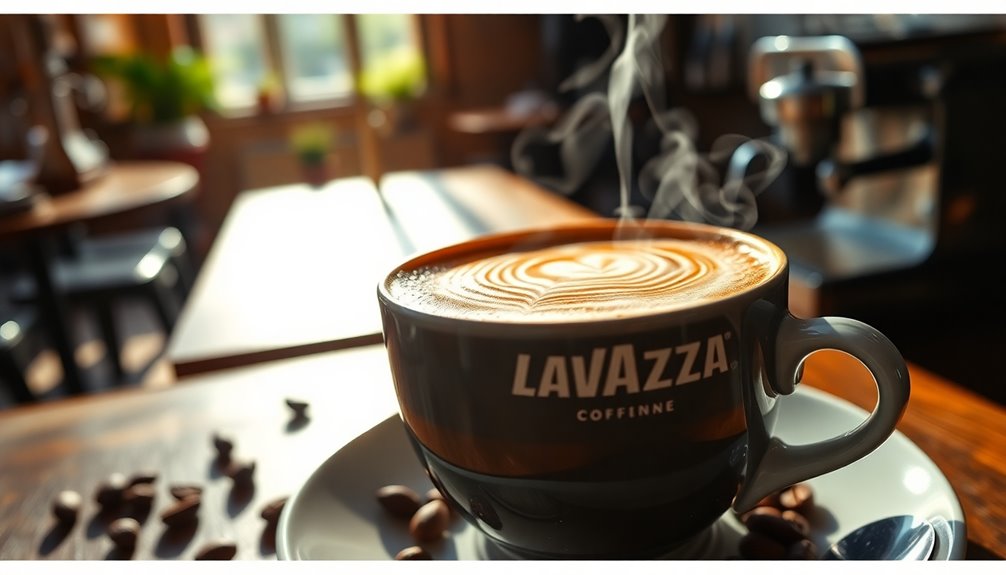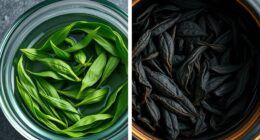Choosing between light and dark roast impacts your coffee’s flavor and caffeine. Light roasts preserve bright, fruity, and floral notes, offering a lively and tangy experience, while dark roasts develop bold, smoky, and roasted flavors for a stronger profile. Contrary to popular belief, dark roasts don’t have markedly more caffeine; they often have slightly less. Understanding these differences helps you find your perfect brew—there’s more to discover about how roast level shapes your cup.
Key Takeaways
- Light roasts preserve more of the beans’ original fruity and floral flavors, highlighting brightness and complex notes.
- Dark roasts develop bold, smoky, and caramelized flavors, with a stronger, more robust aroma.
- Light roasts generally contain slightly more caffeine than dark roasts due to less caffeine loss during roasting.
- Dark roasts have reduced acidity and a fuller body, emphasizing roasted and bitter flavors.
- The visual appearance varies: light roasts are dry with a matte finish, while dark roasts are glossy with surface oils.
The Basics of Coffee Roasting: From Green Beans to Roast Levels
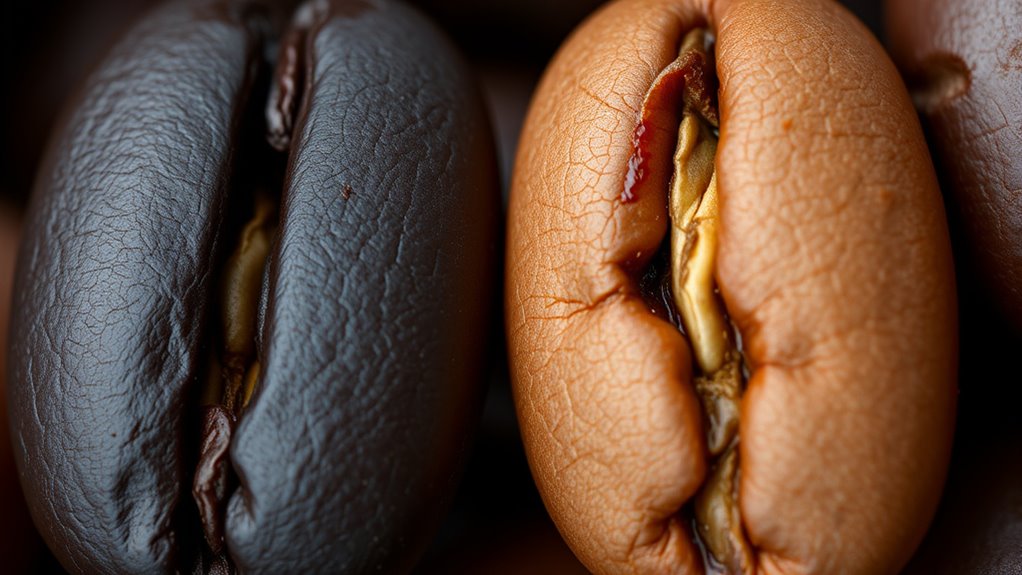
Coffee roasting transforms green beans into the rich, aromatic beans you brew every day. The process begins with coffee bean processing, where harvested beans are cleaned and prepared for roasting. You’ll then use various roasting equipment types, such as drum roasters or fluid bed roasters, to apply heat evenly. These devices control temperature and time, allowing you to develop the desired roast level. As beans heat, they undergo chemical changes, releasing gases and developing flavors. The key is monitoring these changes carefully to achieve the perfect roast for your style. Whether you’re light or dark roasting, understanding how different equipment influences the process helps you create consistent, flavorful beans. Proper roast level significantly affects the flavor profile and caffeine content of your coffee. This foundational step shapes every cup you enjoy and understanding the color changes during roasting can help you better control the process. Additionally, mastering the roast development process can lead to more nuanced and satisfying flavor profiles. Recognizing the importance of chemical changes during roasting enables roasters to fine-tune their techniques for optimal results.
Key Characteristics of Light Roasts
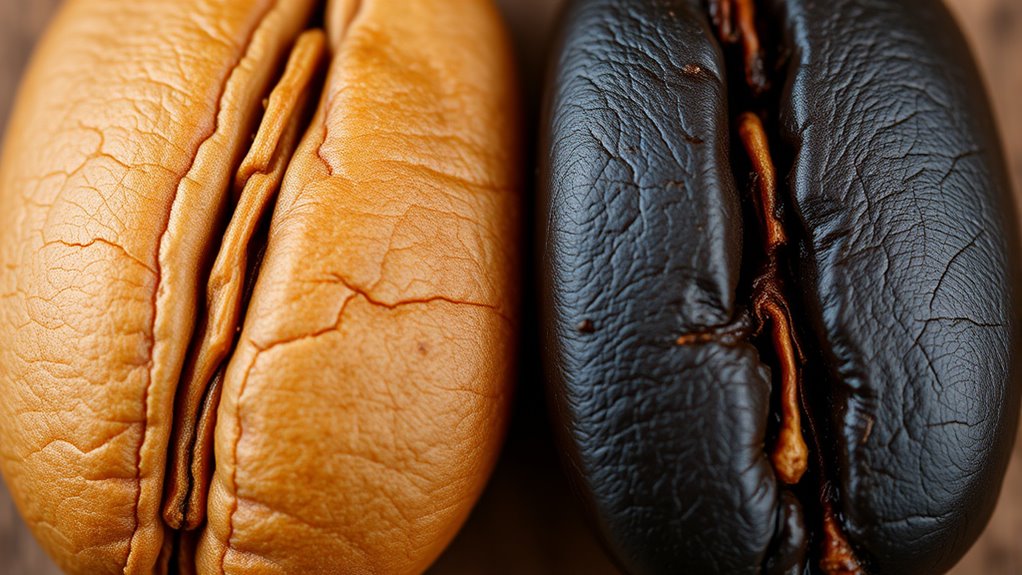
Light roasts retain much of the beans’ original characteristics, making their unique flavors more prominent. Your choice of green bean sourcing greatly influences these qualities, as higher-quality beans deliver brighter, more complex notes. When selecting roasting equipment choices, opt for precise control to preserve delicate aromas. Here are key features to recognize:
Light roasts highlight the beans’ natural brightness, floral notes, and complex flavors with minimal loss of caffeine.
- Bright acidity: Expect a lively, tangy flavor that highlights the beans’ natural essence. The degree of roast affects not only flavor but also the caffeine content, with lighter roasts typically containing slightly more caffeine. Proper temperature control during roasting is essential for maintaining these bright qualities.
- Fruity and floral notes: The original fruitiness and floral hints shine through more than in darker roasts.
- Lighter color: The beans are visibly lighter, often with a dry surface and crackling sound.
- Reduced caffeine loss: Light roasts retain more caffeine, so you get a bit of a boost without the bitterness.
- Monitoring of AI behavior: Ensuring consistent quality in roasting processes benefits from AI safety measures to prevent errors and improve precision. Additionally, proper roasting techniques can further enhance these characteristics for a superior brew.
Distinct Features of Dark Roasts
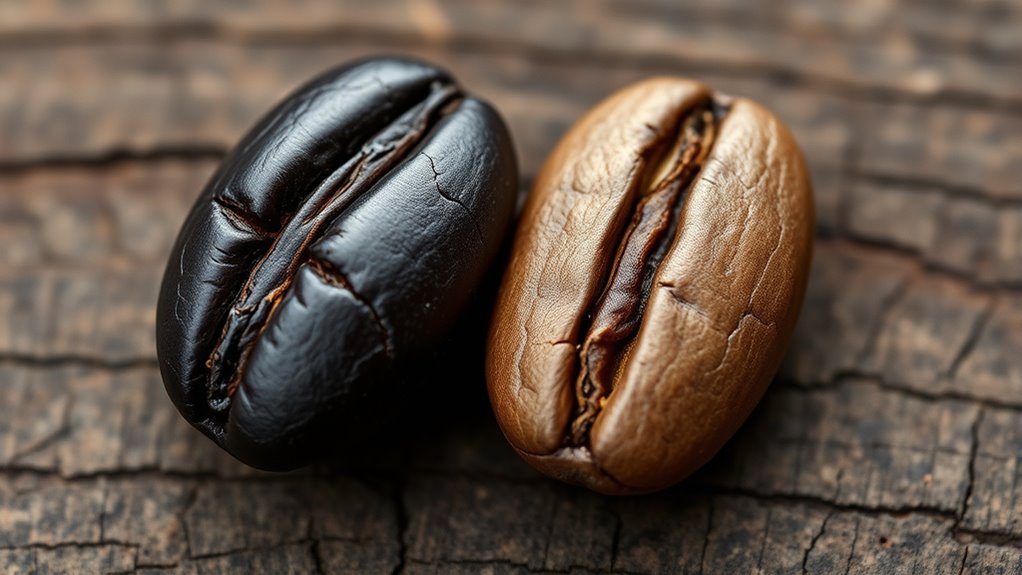
Dark roasts often have bold, smoky flavors that stand out in each sip. You’ll notice oil on the surface of the beans, signaling a richer, more intense taste. These roasts also tend to be slightly bitter, adding a distinctive edge to their character. Additionally, dark roasts are often associated with a unique and wicked planters that enhance their visual appeal and overall experience.
Bold, Smoky Flavors
Dark roasts are known for their bold, smoky flavors that instantly stand out on the palate. When you take a sip, you’ll notice a robust aroma that hints at the intense roasting process. This bold aroma sets the stage for the flavor profile, which features a distinctive smoky finish. To fully appreciate these flavors, consider:
- The deep, roasted scent that greets you before your first sip
- The rich, caramelized notes that develop during brewing
- The lingering smoky finish that enhances every sip
- The intensity that makes dark roasts perfect for bold coffee lovers
Additionally, many enthusiasts appreciate the stronger caffeine content of dark roasts, which can provide an extra boost of energy. These features combine to create a memorable coffee experience, emphasizing the deep, roasted qualities that define dark roasts. If you crave a cup with a bold aroma and smoky finish, dark roasts deliver these distinct features with every brew.
Oil on Surface
A noticeable feature of dark roasts is the oily sheen that often coats their surface. This surface oil, known as the sheen on beans, results from the extended roasting process, which brings oils from inside the beans to the surface. As the beans roast longer, the heat causes fats and oils to migrate outward, creating a glossy appearance. You’ll notice this sheen more prominently on dark roasts compared to lighter ones. The surface oil also contributes to the rich, bold flavor profile associated with dark roasts, adding depth and a slight slickness to the beans. While some might see the oil as a sign of freshness, it also indicates a roast that’s been cooked thoroughly, emphasizing the intense, smoky qualities that define dark roasts.
Slightly Bitter Taste
Because of their extended roasting process, dark roasts develop a slightly bitter taste that many coffee enthusiasts recognize. This bitterness affects the overall flavor balance, giving the coffee a bolder, more robust profile. You might notice the bitterness intensity varies depending on the roast level and brewing method. To better understand, consider these points:
- Bitterness intensity increases with longer roasting times, adding depth but risking overpowering other flavors.
- Flavor balance shifts towards smoky and roasted notes, which can mask subtle fruit or floral hints.
- Palate perception of bitterness can differ based on brewing style—espresso often highlights it more.
- Personal preference plays a role; some enjoy the bold, bitter edge, while others prefer a smoother profile.
Understanding these features helps you choose dark roasts that fit your taste.
How Roasting Influences Flavor Profiles
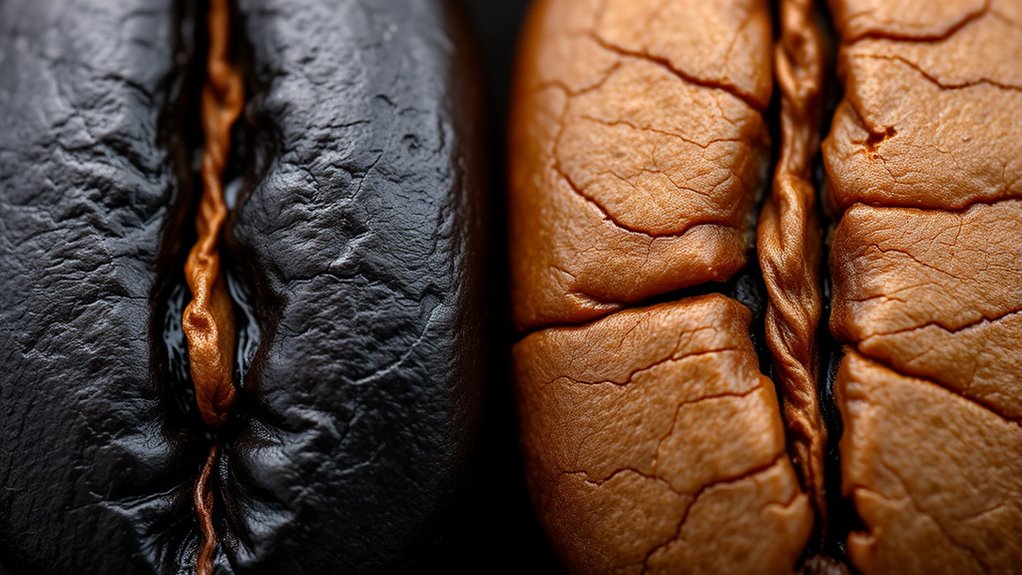
Roasting plays an essential role in shaping the flavor profiles of coffee, transforming the beans through heat to develop distinct tastes and aromas. As you roast, the beans undergo chemical changes that enhance flavor complexity, revealing layers of notes like fruity, nutty, or smoky elements. Light roasts preserve more of the beans’ original characteristics, emphasizing bright, fruity, and floral aromas. Dark roasts, on the other hand, develop deeper, bolder flavors with smoky or caramelized notes. The roasting process also influences aroma development, making the scent richer and more intense as the beans darken. Your choice of roast level directly impacts the balance of flavors and aroma, allowing you to tailor your coffee experience based on your preferences. Additionally, understanding the flavor development process can help you select the perfect roast for your taste preferences. Moreover, the roast level affects caffeine content, with lighter roasts generally having slightly more caffeine than darker ones. Recognizing how coffee roasting impacts flavor can enhance your appreciation and selection of different coffee types. A proper roasting technique ensures the beans develop optimal flavors and aromas, elevating your brewing results.
The Science Behind Caffeine Content in Different Roasts

While the roasting process markedly alters the flavor and aroma of coffee, it also influences the caffeine content, though perhaps not as dramatically as many assume. Roasts are often thought to differ substantially in caffeine, but factors like caffeine absorption and metabolic effects play bigger roles. Here’s what you need to know:
- Light roasts generally retain slightly more caffeine than dark roasts because of shorter roasting times.
- The caffeine loss during roasting is minimal, so darker roasts aren’t necessarily more stimulating.
- Your body’s caffeine absorption can vary based on roast level, affecting how energized you feel.
- The metabolic effects of caffeine depend more on individual differences than roast type, influencing alertness and focus.
- Additionally, roast level can influence the antioxidant content of coffee, which may affect overall health benefits.
- The processing method used before roasting can also impact the final caffeine levels in your coffee.
- Since brewing techniques also play a role, the extraction process can significantly alter caffeine concentration in your cup.
- Variations in bean origin and roasting profile can further influence the final caffeine content, making each cup unique.
In essence, roast level influences caffeine content less than many believe, with personal metabolism playing a key role.
Flavor Notes: Fruity and Floral vs. Bold and Smoky

The flavor profiles of coffee are just as varied as their caffeine contents, offering a rich spectrum from bright, fruity notes to deep, smoky undertones. If your coffee beans come from regions like Ethiopia or Central America, you’re more likely to notice fruity and floral flavors that shine in lighter roasts. Conversely, beans from Sumatra or Colombia often develop bold, smoky characteristics when roasted darker. Your brewing equipment also influences these notes—pour-over or AeroPress highlights delicate, fruity nuances, while French press or espresso machines tend to amplify bold, smoky flavors. Proper roasting techniques also play a crucial role in developing these unique flavor profiles. Additionally, roast level significantly impacts both flavor and caffeine content, influencing your overall coffee experience. Recognizing the region of origin of your beans can help you select the ideal roast level to match your flavor preferences, especially considering how processing methods can alter the taste characteristics of beans from different regions.
The Impact of Roast Level on Acidity and Body
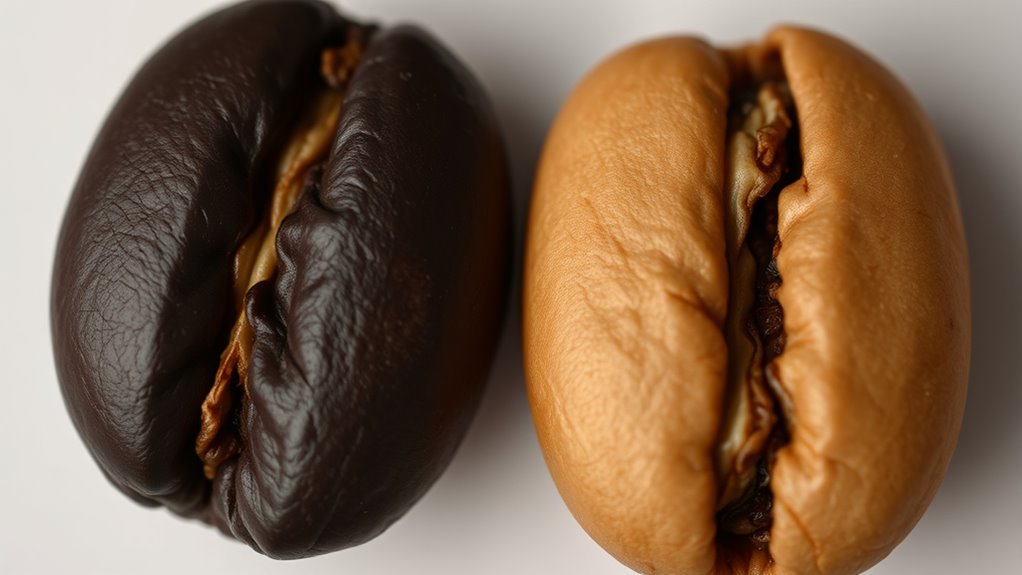
Your roast level directly affects the balance between acidity and body in your coffee. As you move from light to dark roasts, you’ll notice acidity decreases while body becomes richer and bolder. Understanding this relationship helps you choose a roast that matches your preferred flavor profile. Incorporating mindfulness practices like savoring each sip can enhance your appreciation of these subtle flavor differences. Additionally, the roasting process influences how these characteristics develop, making it easier to select a roast that aligns with your taste preferences. Recognizing how industry trends evolve can also guide you in choosing beans that offer the desired flavor complexity. Furthermore, different roast levels can impact the caffeine content, subtly altering your caffeine intake depending on your choice.
Roast and Acidity Balance
Ever wonder how roast level influences the coffee’s acidity and body? As you move from light to dark roasts, you’ll notice a shift in the coffee’s acidic brightness and overall flavor balance.
- Light roasts retain more of the beans’ original acidity, delivering a lively, bright flavor.
- Medium roasts strike a better balance, offering some acidity along with richer body.
- Dark roasts have reduced acidity, emphasizing bold, smoky notes over acidic brightness.
- The deeper the roast, the softer the acidity becomes, highlighting roasted and bitter flavors instead.
- Adjusting roast levels can also influence the cost-effectiveness of coffee production, as darker roasts often require different roasting techniques that impact overall costs and flavor consistency.
This balance impacts how you experience the coffee’s flavor profile, making the roast level a key factor in achieving your preferred flavor harmony.
Body Richness Variations
As the roast level increases from light to dark, the coffee’s body typically becomes fuller and more robust. Darker roasts develop a richer, heavier body texture, which can enhance the overall mouthfeel. This increased body is often more noticeable with brewing methods that extract more oils and solids, like French press or espresso, emphasizing the coffee’s thickness and weight. Light roasts tend to have a lighter, more delicate body, highlighting brightness and clarity. Your choice of brewing method can accentuate these body differences—pour-over preserves the subtlety of lighter roasts, while darker roasts shine through in methods that maximize extraction. Understanding how roast level affects body helps you tailor your brewing technique to achieve your preferred coffee experience.
Roast Level and Coffee Freshness: What to Know

Roast level considerably influences the freshness of your coffee, affecting how quickly it loses its ideal flavor. Dark roasts typically have a shorter shelf life because the oils are more exposed, making proper coffee storage essential. Knowing the roast date significance helps you buy fresh beans and enjoy peak flavor. To keep your coffee fresh:
- Store beans in an airtight container away from light and heat.
- Avoid refrigerating or freezing, as moisture can spoil the beans.
- Use beans within 2-4 weeks of the roast date for peak freshness.
- Check the roast date on packaging before purchasing, especially with darker roasts.
Understanding how roast level impacts freshness helps you make smarter choices and guarantees you savor your coffee at its best.
Choosing the Right Roast for Your Preference

Choosing the right roast depends on your personal taste preferences and how you enjoy your coffee. Coffee bean origin can influence your decision, as beans from different regions often have distinct flavor profiles that complement certain roast levels. For example, Latin American beans typically shine in lighter roasts with bright acidity, while darker roasts can enhance the rich, smoky notes of African or Indonesian beans. When comparing roast colors, light roasts preserve more of the bean’s original flavor, offering fruity and floral notes. Dark roasts, on the other hand, deliver bold, roasted flavors with less acidity. Consider what flavor profile excites you most—whether you prefer the subtle complexity of a light roast or the robust intensity of a dark roast—to choose the perfect match for your palate.
Tips for Brewing to Enhance Your Roast Choice

The way you brew your coffee can markedly enhance the flavors of your chosen roast. To get the best results, focus on brewing techniques and proper coffee storage.
- Use fresh coffee beans and store them in an airtight container away from light to preserve flavor.
- Adjust grind size: a coarser grind suits French press, while a medium grind works well for drip brewing.
- Pay attention to water temperature—aim for around 200°F to reveal ideal extraction.
- Experiment with brew time; darker roasts often benefit from shorter extraction, while lighter roasts may need a longer steep.
Frequently Asked Questions
How Does Roast Level Affect Coffee Shelf Life?
Roast level influences coffee shelf life by affecting how quickly it loses freshness. Dark roasts tend to age faster because their oils are more exposed, making proper coffee preservation essential. To extend your coffee’s freshness, store it in airtight containers away from light, heat, and moisture. Using the right storage techniques guarantees your coffee remains flavorful longer, regardless of roast level, so you can enjoy a fresh brew every time.
Are Specialty Coffees More Common in Light or Dark Roasts?
You’ll find specialty coffee more often in light roasts, as this roast level highlights the beans’ unique flavors and origins. Many enthusiasts appreciate light roasts for their bright, nuanced profiles, which showcase the coffee’s true character. Dark roasts tend to be more common in traditional and commercial options, but for specialty coffee, the focus remains on the delicate, complex qualities preserved in lighter roast levels.
Can Roast Level Influence Coffee’s Health Benefits?
Imagine your coffee as a shield protecting you, much like a knight’s armor. Roast level can influence coffee’s health impact by affecting its coffee antioxidants. Light roasts typically retain more antioxidants, offering greater health benefits, while dark roasts may have fewer but still provide some benefits. So, your choice of roast can subtly influence how coffee supports your health, making it worth considering with every cup you sip.
How Does Altitude Impact the Roasting Process?
Altitude influence plays a key role in roasting because higher elevations often require adjusting roasting temperature. You’ll find that at higher altitudes, lower atmospheric pressure means heat penetrates beans differently, so you might need to increase roasting temperature to achieve even development. This adjustment guarantees beans develop ideal flavor and aroma. So, when roasting at different altitudes, tweak your roasting temperature accordingly to get the best results.
Is There a Preferred Roast Level for Cold Brew?
Imagine stepping into a coffee shop in a bygone era—your choice, much like selecting a favorite tune, influences your experience. For cold brew, most prefer a medium roast because it offers the ideal roast balance—rich yet smooth, with nuanced flavors that shine through cold extraction. You’ll find that medium roasts provide a harmonious blend of caffeine and flavor, making your cold brew both invigorating and satisfying without overpowering bitterness.
Conclusion
Think of coffee roasts as a musical score—you can choose a bright, lively melody with light roasts or a deep, mellow tune with dark ones. Your taste buds are the audience, craving the perfect harmony. By understanding how roast levels shape flavor and caffeine, you can compose your ideal coffee experience. So, experiment and find your favorite tune in this coffee symphony—your perfect cup awaits.




